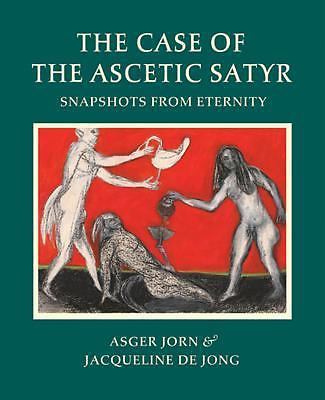Picture 1 of 1

Stock photo

Picture 1 of 1

Stock photo

Asger Jorn and Jacqueline de Jong: the Case of the Ascetic Satyr : Snapshots from Eternity by Jacqueline de Jong (2015, Trade Paperback)

Midtown Scholar Bookstore (180012)
99.8% positive feedback
Price:
US $217.14
(inclusive of GST)
ApproximatelyS$ 279.11
+ $29.04 shipping
Returns:
30 days return. Buyer pays for return shipping. If you use an eBay shipping label, it will be deducted from your refund amount.
Condition:
Oops! Looks like we're having trouble connecting to our server.
Refresh your browser window to try again.
About this product
Product Identifiers
PublisherD.A.P./Distributed Art Publishers
ISBN-101938922867
ISBN-139781938922862
eBay Product ID (ePID)219184576
Product Key Features
Number of Pages56 Pages
Publication NameAsger Jorn and Jacqueline De Jong: the Case of the Ascetic Satyr : Snapshots from Eternity
LanguageEnglish
SubjectConceptual, Individual Artists / Artists' Books, Subjects & Themes / Erotica, European
Publication Year2015
TypeTextbook
AuthorJacqueline De Jong
Subject AreaArt
FormatTrade Paperback
Dimensions
Item Height0.3 in
Item Weight28 Oz
Item Length12 in
Item Width9.5 in
Additional Product Features
Intended AudienceScholarly & Professional
ReviewsFar more than any conventional memoir, the book catches the real mood, the ambience, of a love affair: the way it is, spinning from desire into loss, fury into abasement, everything heightened, everything new.
IllustratedYes
SynopsisIn 1962, while living in Paris, Dutch painter, sculptor and editor of The Situationist Times Jacqueline de Jong (born 1939) completed a set of 11 woodcut engravings, a medium in which she rarely worked. Danish painter and writer Asger Jorn (1914-1973) adored the engravings and decided to publish them. First, however, Jorn decided to compose a set of texts to accompany the art work, turning the suite of engravings into an "erotic novel" which they called "The Case of the Ascetic Satyr." Over the course of the next decade they jotted down playful (and occasionally sexually explicit) notes to each other on anything that came to hand--exhibition flyers, cocktail napkins, even an unused sheet from Memoires , Jorn's famous collaborative artist's book with Guy Debord. The texts are mostly in English, the language Jorn and de Jong usually used together, though some are in French, Danish, Dutch or German. Wordplay is prevalent, sometimes referring to James Joyce's Finnegans Wake . In the end, the book project outlasted the relationship between the two artists, and so was never published. This beautifully produced artist's book--published in a signed and numbered edition of 200 copies--is thus not so much a facsimile as a true first edition, with the prints accompanied by replicas of the notes between the two lovers. A companion volume includes essays on the piece by leading art historians in the field, Kevin Repp, Marc Lenot, Roberto Ohrt, Karen Kurczynski and Axel Heil., In 1962, while living in Paris, Dutch painter, sculptor and editor of The Situationist Times Jacqueline de Jong (born 1939) completed a set of 11 woodcut engravings, a medium in which she rarely worked. Danish painter and writer Asger Jorn (1914 1973) adored the engravings and decided to publish them. First, however, Jorn decided to compose a set of texts to accompany the art work, turning the suite of engravings into an "erotic novel" which they called "The Case of the Ascetic Satyr." Over the course of the next decade they jotted down playful (and occasionally sexually explicit) notes to each other on anything that came to hand--exhibition flyers, cocktail napkins, even an unused sheet from Memoires , Jorn's famous collaborative artist's book with Guy Debord. The texts are mostly in English, the language Jorn and de Jong usually used together, though some are in French, Danish, Dutch or German. Wordplay is prevalent, sometimes referring to James Joyce's Finnegans Wake . In the end, the book project outlasted the relationship between the two artists, and so was never published. This beautifully produced artist's book--published in a signed and numbered edition of 200 copies--is thus not so much a facsimile as a true first edition, with the prints accompanied by replicas of the notes between the two lovers. A companion volume includes essays on the piece by leading art historians in the field, Kevin Repp, Marc Lenot, Roberto Ohrt, Karen Kurczynski and Axel Heil., In 1962, while living in Paris, Dutch painter, sculptor and editor of "The Situationist Times" Jacqueline de Jong (born 1939) completed a set of 11 woodcut engravings, a medium in which she rarely worked. Danish painter and writer Asger Jorn (1914-1973) adored the engravings and decided to publish them. First, however, Jorn decided to compose a set of texts to accompany the art work, turning the suite of engravings into an "erotic novel" which they called "The Case of the Ascetic Satyr." Over the course of the next decade they jotted down playful (and occasionally sexually explicit) notes to each other on anything that came to hand--exhibition flyers, cocktail napkins, even an unused sheet from "Memoires," Jorn's famous collaborative artist's book with Guy Debord. The texts are mostly in English, the language Jorn and de Jong usually used together, though some are in French, Danish, Dutch or German. Wordplay is prevalent, sometimes referring to James Joyce's "Finnegans Wake." In the end, the book project outlasted the relationship between the two artists, and so was never published. This beautifully produced artist's book--published in a signed and numbered edition of 200 copies--is thus not so much a facsimile as a true first edition, with the prints accompanied by replicas of the notes between the two lovers. A companion volume includes essays on the piece by leading art historians in the field, Kevin Repp, Marc Lenot, Roberto Ohrt, Karen Kurszinski and Axel Heil.
Text byOhrt, Roberto, Repp, Kevin, Lenot, Marc
Be the first to write a review





